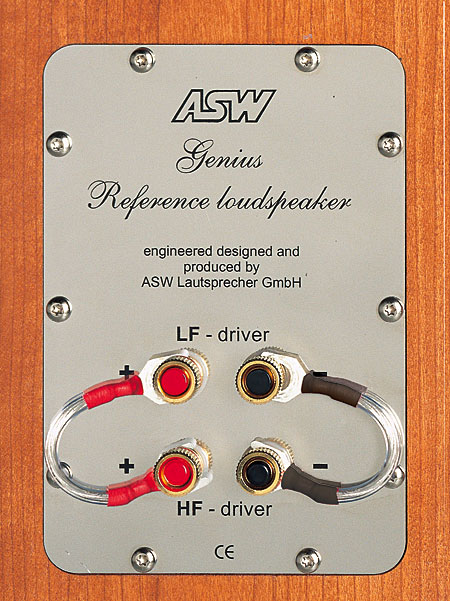| Columns Retired Columns & Blogs |
ASW Genius 100 loudspeaker Page 2
The Genius 100's superb bass performance revealed another dimension of jazz and classical recordings. For a bookshelf speaker, its midbass extension with all recordings was surprisingly forceful and uncolored. Ray Brown's solo on "I'm an Old Cowhand," from Sonny Rollins' Way Out West (CD, JVC VICJ-60088), was even throughout the double bass's entire range, as well as uncolored and well defined, if slightly warm in the instrument's lower register, as it should be. The organ pedals in the Rutter Requiem were clean, forceful, and extended. Although the Genius 100s didn't shake my room, I can't think of another bookshelf speaker I've heard that could more realistically reproduce the sound of organ-pedal notes. Finally, Tyler Mack's solo timpani passages in Tomiko Kohjiba's Transmigration of the Soul, from the Santa Fe Chamber Music Festival's Festival (CD, Stereophile STPH007-2), sounded natural and vibrant.

I discovered a paradox about the Genius 100. You'd think a bookshelf speaker able to produce such realistic bass and such wide dynamic swings wouldn't mind being cranked up to high volume levels, and sure enough—with more demanding and complex recordings played at louder volumes, the ASW's bass performance and sense of dynamic slam began to resemble those of a more expensive floorstander. The problem was that, as I raised the volume level with these recordings, the high frequencies began to lose their tonal purity.
For example, I cut loose at fairly high levels with "Dog Breath Variations" and "Uncle Meat" from The Yellow Shark, Peter Rundel and Ensemble Modern's recording of orchestral music by Frank Zappa (CD, Barking Pumpkin R2 71600). In the more highly modulated passages the high frequencies became a touch wiry, even the glockenspiel. I experimented with the volume with "Man Machine," from Kraftwerk's Minimum/Maximum (CD, EMI ASW 60611). At medium volumes, the bass instruments were forceful and punchy, with great dynamic slam, and the fast, zippy, high-frequency transients were appropriately crisp on top. However, as I increased the volume to concert levels, the crispness took on that same wiry quality.
At extreme volumes, the Genius 100 sounded bright. In an attempt to replicate rock-concert levels, I spun Jeff Beck's rendition of Stevie Wonder's "Because We've Ended as Lovers," from Eric Clapton's Crossroads Guitar Festival (DVD, Rhino R2 35212 4); the ASWs overemphasized Beck's guitar. I then cranked up the title track of Hole's Celebrity Skin (CD, Geffen DGCD-25464) to the level (+100dB) at which I start to dance around the room, and all voices and instruments were quite blarey in the highs.
But at normal listening levels, the Genius 100 was a pleasure to listen to with a broad range of material. In the André Previn performance of Messiaen's Turangalîla Symphony (UK LP, EMI SLS 5117), the upper-register piano transients were startling but delicate, and it was easy to pick out the bassoon figures way down in the mix. I could hear the subtle dynamic inflections of the gong, and the Genius 100's excellent clarity allowed me to focus on the interplay of cello and clarinet while ignore all the other instruments. The bass-drum blast at the end of the Turangalîla second movement could not have sounded more natural or dramatic. A recording that put all of the ASW's strengths together was Antal Dorati and the London Symphony's of Stravinsky's The Firebird (LP, Mercury Living Presence/Classic SR 90226). I could easily focus on the tutti pizzicato strings' subtle crescendo from ppp to p, and was able to clearly follow each trombone. All instruments breezed through high-level passages effortlessly without strain; the bass drum even shook the room a bit.
Comparisons
I compared the ASW Genius 100 ($1395) with the Nola Mini ($695 when last offered), the Amphion Helium2 ($1000), and the Monitor Audio Silver RS6 ($1000). All speaker prices are per pair.
The Nola Mini's midrange was as impressive as the ASW's, although the Genius 100 had a slightly richer quality there. High-frequency sibilants seemed a bit clearer through the ASW, but the Nola's bass extension and high-level dynamic performance were superior. However, the Nola's midbass seemed a bit warmer overall than the ASW's.
The Amphion Helium2 shared the Genius 100's pure, silky midrange and revealed even more detail, but its highs were sweeter, more romantic and airy, with a high level of detail. Bass extension and high-level dynamics were inferior to the ASW's, however.
The floorstanding Monitor Audio Silver RS6, too, revealed considerable midrange detail, and its high frequencies were clean and crisp, with lightning-fast transients, although the Genius 100 had a bit more air at the very top. The Monitor's bass extension and high-level dynamics, however, were the best of the four.
Punchline
I was very pleased with all of the listening time I spent with the ASW Genius 100. When not pushed too hard, this loudspeaker was a detailed, neutral, dynamic-sounding performer that breathed like live music over a wide range of program material. Moreover, it's attractive and a good value. I hope that ASW becomes a greater presence in the US; more audiophiles should get the chance to audition their speakers.
- Log in or register to post comments




































